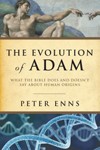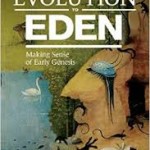Last week I spoke to a gathering of pastors from the NY Metro presbytery of the Presbyterian Church of America on the problem of evolution and Adam. This topic is a particularly pressing problem for this denomination, since the Westminster Confession of Faith (their doctrinal standard written around 1650) presumes, understandably, that Adam was the first human, created specially by God without any preceding evolutionary process.
I thought I’d summarize what I said to these pastors. My aim was not to force upon anyone views they are not prepared to ingest, but simply to present the options, my own position, and why I arrived at it.
So, my first point was to lay out the options for thinking about Adam in view of evolution.
Evolution can either be accepted (in some form) or wholly rejected. If rejected, one has no problem with an historical Adam as first man, but then one has to find ways to neutralize the scientific data, which is attempted in various (but unconvincing) ways. (Google Al Mohler, Ken Ham, and Hugh Ross.)
No need to get into that here. This group of pastors was already (largely) aware that evolution cannot be dismissed, and so we proceded to other things.
If one accepts evolution, the first thing to note is that one has left the biblical worldview. I think this is an obvious point, but needs to be stated clearly. As soon as evolution is accepted, the invariably result is some clear movement away from what the Bible says about Adam.
Hence, if one wishes to bring Adam and evolution into conversation, one is left with the theological burden and responsibility of bringing them together somehow in a manner does justice to both. The second part of my talk was focused on how that conversation can proceed with integrity (see below).
Back to the flow chart.
So, once one accepts evolution, the question becomes “what do I do about Adam?” I see two choices: Adam is either historical (in some sense) or he is not.
If one wishes to retain a historical Adam, the two options I am aware of (if you know of others, please let us know) are:
(1) “Adam” was a hominid chosen by God somewhere along the line to be the “first man”;
(2) “Adam” was a group of hominids (a view that accounts best for the genomic data that the current human population stems from a few thousand ancestors, definitely not two ancestors).
In my opinion, these two options fail for the same two reasons:
(1) They are ad hoc, meaning that are invented for the sole purpose of finding some way to align the Bible and science. It is generally a good idea to avoid ad hoc explanations, and we rarely tolerate them when others make use of them.
(2) The “Adam” that results from these ad hoc maneuvers is not the Adam that the biblical authors were talking about (a chosen first pair or group of hominids). No biblical teaching is really protected by inventing “Adam” in this way.
This brings us to a non-historical Adam–meaning Adam in the Bible as parabolic, metaphorical, symbolic, or “supra-historical” (a term I learned from Richard Clifford, meaning a truth transcends history but told in historical terms, and therefore not meant to be taken literally).
I gave three options for a non-historical Adam (there are more). The red line joining them indicates that these options are not so much distinct as they are variations on the larger category “non-historical.”
One option is to understand Adam as a literary figure, which would relieve the pressure of thinking of Adam as the first human. A mythical understanding–which is the most common, I think, among scholars of the Bible and the ancient world–means that the story of Adam is a concrete expression of a deeper reality. (Some would argue that story is really the best form to communicate “deep reality,” but we’ll leave that to the side.)
A third option, which I throw in because I happen to think it has a lot of merit, is to see the story of Adam as a story of Israel and not as the story of the first human. I will explain that more in my next post.
Anyway, those are the options as I see it. Which option(s) is(are) best depends on one thing: accounting well for the relavant exegetical and historical factors.
That is the subject of the next post, but let me preview it here briefly. Any attempt to account for Adam in an evolutionary scheme will have to account for “data.” Scientists work this way, too. “Models” that account for most of the data well (not forced, ad hoc, or idiosyncratic) are models that need to be considered.
Bringing Adam and evolution into serious conversation is really a matter of building convincing models.











